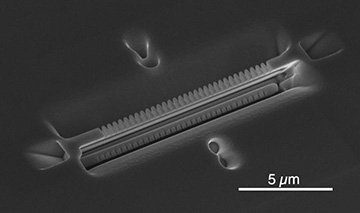
Scanning electron microscope image shows a nanophotonic cavity used by researchers to entangle single ions and photons. The technology might allow quantum computers to link up with one another in the future. [Image: Faraon lab/Caltech]
While today’s internet allows data to be shared easily between classical computers, scientists are laying the groundwork for a network that would enable more powerful quantum computers to talk to one another.
Engineers at the California Institute of Technology (Caltech), USA, have now taken an important step toward such a quantum internet by showing how remote quantum bits (qubits) could potentially be linked together by coupling them to photons inside tiny optical cavities (Nature, doi: 10.1038/s41586-020-2160-9).
Toward pure quantum communications
Using quantum mechanics to enhance communication is not a new thought. For many years, physicists have been developing schemes that encrypt and decrypt data using keys encoded in the states of a series of quantum particles. The idea is that any eavesdropper attempting to copy the key would give their presence away by altering the states and introducing detectable errors into the key.
Indeed, some companies produce such quantum-key distribution systems commercially, for example, to protect banking transactions or election counts. Researchers in China, meanwhile, are building a secure network involving some 2000 km of fiber optic cable to link four cities across the country.
However, these networks are not fully quantum. If data are to be sent over long distances, they need to be re-generated periodically using devices known as repeaters. But repeaters today are partly classical, which makes them vulnerable to hackers.
As such, scientists are trying to build a network that links quantum processors using purely quantum links. Typically, this would involve computers hooking up via photonic qubits, which would be replenished at repeaters that convert the photonic qubits into matter qubits and back again. Once achieved, this might mean being able to combine the calculating power of relatively small quantum computers to solve otherwise intractable problems, or to create Earth-sized telescope arrays even at optical frequencies.
Taking advantage of rare-earth elements
Andrei Faraon and colleagues at Caltech have shown how that might be done using matter qubits made from ions of ytterbium. Rare-earth elements such as ytterbium are good candidates for qubits because they are resistant to interference from the electric and magnetic fields that would otherwise destroy their quantum states. On the other hand, they don’t interact strongly with photons. The Caltech team demonstrated how to enhance that interaction using a 10-μm-long optical cavity made from the crystal yttrium orthovanadate.
The Caltech group illuminated a single ytterbium ion at the center of the cavity with laser light, causing the ion to emit single photons with the cavity’s resonant frequency. The spin of those photons is entangled with the spin of the ion. The researchers found that more than 99% of the photons remain in the cavity when emitted, making it easier to measure the state of the ion and to eventually enable a communication link with a high bit rate.
What’s more, they say, because the ion remains in a coherent spin state for about 30 milliseconds, such a link could potentially be used to transmit information over thousands of kilometers—such as across the continental United States. The researchers also showed that they could maintain this coherence at temperatures of up to 1.2 Kelvin, which, they say, could enable devices that can operate using relatively cheap helium-4 cryogenics.
Multiple methods, one goal
Faraon points out that his is not the only group to have entangled single ions and photons. Indeed, Jeffrey Thompson and colleagues at Princeton University, USA, have reported similar results using erbium ions. Erbium has the advantage of operating at telecommunication wavelengths, allowing photons to propagate further along optical fibers. However, says Faraon, the erbium scheme as envisaged is very sensitive to electric and magnetic fields.
Other groups, meanwhile, are looking at qubits made from atomic impurities in diamond, but these too face challenges. Ronald Hanson at the Delft University of Technology in the Netherlands and co-workers have linked two qubits involving nitrogen vacancies, but according to Faraon the qubits’ optical coherence degrades when they are embedded in small optical cavities. Mikhail Lukin’s group at Harvard University, USA, on the other hand, has obtained good stability and coherence using silicon impurities but has to work at very low temperatures.
Faraon says that his group hopes to link up two ytterbium qubits by 2022. With any luck, he adds, the genesis of a quantum internet might emerge around 2025.
